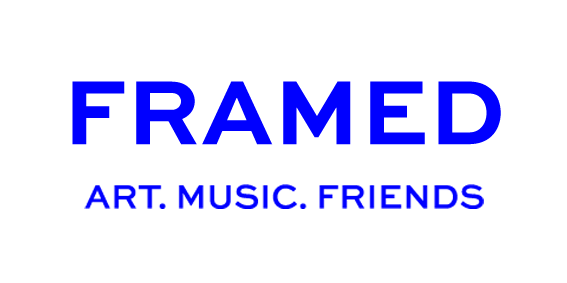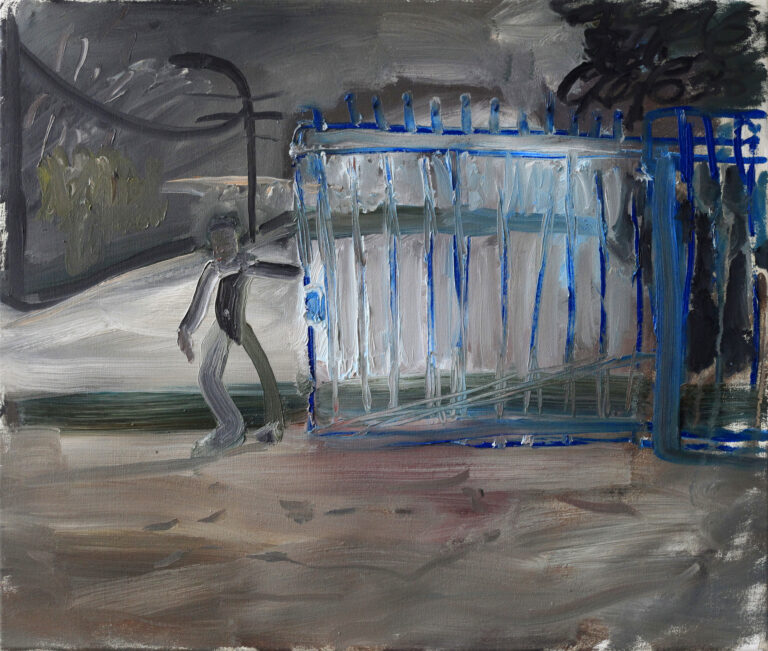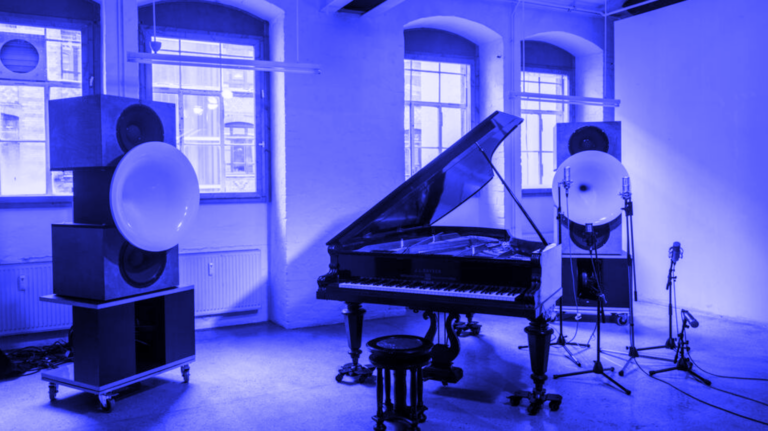Ofir Dor :
Maybe you could tell us briefly about what drove you to put up this two person show, what do you see as the essence of this pairing?
Katharina & Max Renneisen :
We are partners in life and have been working side by side for years, our studios being located next to each other with a connecting door. Therefore, it has always felt natural to us to talk about our art on a daily basis.
No matter whether our views and ideas complement, expand or contradict each other, these dialogues have proven to be very fruitful for both of us.
In fact, we have realised that they constitute an essential part of our work and set the direction.
This is also reflected in the works themselves: Generally, we both share a figurative approach as well as a preference for craftsmanship and classical subjects. Although we work in different media, the respective other medium plays an important role in our work processes, as Max uses photographic source material for his paintings and Katharina hand-colours many of her black-and-white photographic prints.
A joint exhibition gives us the opportunity to make the multiple interrelationships between our works visible
and to add a new dimension through their juxtaposition.
“Every Wave Is New” will be our third two-person show and like the last times, we have selected pieces that are also thematically intertwined: Waves and water appear in Katharina’s landscapes as well as in the backgrounds of Max’s depictions of animals and nudes.
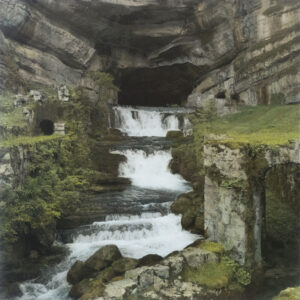
„The Source of the Loue“, 2021
Oil on silvergelatin print, 49 x 49 cm
O.D :
Your Oeuvres maintain elaborate interrelation between painting and photography. The ralls keep swapping; paintings based on photographs (themselves based on image tradition stemming from painting). On the other hand, photographs referring to landscape painting, which might look almost like painting, and goes extremely close by being hand painted. Could you say something about that?
K.R & M.R :
In today’s digital age, visual culture is characterised by an abundance of images. We both have a background in art history and view pictorial history as an inexhaustible repertoire of images, from which we derive many of our ideas and iconographies. Already existing pictures, be they works of art or photographs from mass and everyday culture, often serve us as inspiration, starting point or source material for our art. Inevitably, this transformation process is also always about media reflection and the question of what one can add to one’s own medium on the basis of its history.
Since photography has had a complex interrelationship with painting since its invention, we are also concerned with the interface between the two media.
In her body of work “Paysage”, Katharina develops an approach to the landscape genre which combines photographic and painterly techniques into a synthesis. For her motifs, she mainly draws inspiration from French landscape art of the 19th century. At the time, both painters and photography pioneers discovered their native nature as a subject matter and eternalised places like the forest of Fontainebleau, the Loue valley or the Norman coast. Starting from this classical image repertoire,
Katharina conducts research about potentially interesting places, and if they appear to be worthy of depiction today, she visits them. On location, she uses an analogue large or medium format camera in order to capture nature in a level of detail which can only be achieved with photographic means.
Back in the darkroom, she develops the black-and-white negatives and makes silver gelatin prints from them, which she then hand-colours with oil paints. However, this technique is by no means chosen out of nostalgia, but because it offers a freedom of interpretation which is closer to painting than any analogue colour photographic process or digital photography. By using the silver gelatin prints like a grisaille underpainting and glazing oil paints over them, the photographic momentariness is at once retained and transcended. The results are equally immediate and timeless landscape images.
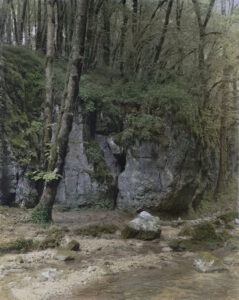
„Puits Noir I“, 2021
Öl auf Silbergelatineabzug, 99 x 79 cm
In a similar way,
Max’s works are also based on many different influences. In his creation process, he combines inspirations from the history of painting and from modern imagery in order to develop a contemporary approach to classical themes of painting, such as animal depiction and the nude in nature.
In both bodies of work, the backgrounds show landscape settings in the manner of Old Masters paintings, while the figures in the foreground derive from photographic source material. As to the animals, the countless high-quality photographs of the different species available online offer hitherto unprecedented possibilities to study them close-up. However, Max never simply translates single animal photographs into painting, but always considers several images as well as the information about the respective species he gathers from books, documentaries and visits to zoos and natural history museums. Ultimately, he intends to arrive at condensed depictions of individual creatures and ideal representatives of a species at the same time. The photographic source material for the human figures, on the other hand, stems mainly from nudist magazines from the 20th century. Among the more or less staged photographs, Max keeps discovering images in which the poses of the nude figures correspond to the classical iconography of the body. When transforming them into painting, he aims at retaining their snapshot-like quality, while at the same time giving them artistic grandeur through their painterly realisation.

„Helio Beach“, 2022
Oil on canvas, 160 x 110 cm
O.D :
Max paints figures, be they humans or other animals, while in Katharina’s pictures what stands out is their absence. How do you see the relationships between figure and landscape?
K.R & M.R :
Pure landscape works, like Katharina’s hand-coloured photographs, principally have a higher degree of abstraction than in combination with figures. Their main subjects involve the elements of nature themselves, their structures and composition, but also the established sense of place and the evoked atmosphere. While the real size of a depicted scenery cannot always be clearly determined, the introduction of figures automatically sets the scale and, unless they are mere staffage, the figures become the protagonists of the picture. This also applies to Max’s paintings, in which the animals and humans are in most cases placed dominantly in the foreground. The landscape backgrounds serve to further characterise the figures and to reveal their relationship to the surrounding nature. In his “Menagerie”, Max frequently suits the landscape compositions to the depicted animals. Drawing inspiration from the great tradition of portrait painting, he constructs landscapes with low horizons, vast views and vivacious skies in order to make the animals appear as imposing and dignified beings. Here, the figures and the landscapes are in harmony, whereas in the “Paradise Lost” cycle, tensions and ruptures between the two pictorial elements prevail. Although unified by their painterly realisation, the different source materials in terms of medium and time of origin are discernible in the finished works. In the ideal landscapes, the nude figures often seem out of place, their actions sometimes even awkward, their haircuts and accessories like strange indications of a civilisation they apparently cannot do without.

„Humboldt-Penguin V“, 2023
Öl auf Leinwand, 60 x 50 cm
O.D:
As for the subject matter, in Katharina’s work, when we’re looking at a place, barred of personages and action, we are left with the presence of the elements, in such case the protagonists are Water – Trees – Shrubbery – Rock – Sky, and the drama is what happens between them. In max’s case, a tiny imbalance, distortion or hinted action creates the symbolic meaning of the painting, for example: the watch on the girl’s wrist as a meta symbol of time and mortality, same as a girl’s toe slightly touching the surface of running water. Are you led by this kind of story telling, or dramatic associations? or is it a subconscious layer of your work?
K.R & M.R :
Generally, we both consider ourselves as formalists and pursue an artistic approach which could probably best be described as “l’art pour l’art”. Therefore, our creation processes are guided more by aesthetics and iconographies than by storytelling and dramatic associations.
Accordingly,
Katharina favours landscape subjects which are aesthetically and compositionally appealing. But landscape depiction is never only about the landscape itself, but also always about its meaning, and in this respect, she prefers motifs with a mythological depth.
This can be an oak tree, a source or a more complex scenery in which the interplay of the elements evokes a magical atmosphere. Some of her works, such as “Puits Noir II”, could even serve as imaginary settings for mythological stories, such as Wagner’s “Ring” cycle.
When Max searches nudist magazines for possible motifs, he usually first pays attention to the poses and to the illumination of the bodies. It is often only at second glance that he discovers the symbolic character of an action,
such as the touching of the water surface with a toe, or an attribute, such as the watch, and what they reveal about the respective figure. Eventually, these picture elements add an additional level of meaning, which is in many cases crucial for the choice of the title and thus the interpretation of the work.
O.D:
And time, looking at both works, there is obviously a strong sense of continuity, a lineage of image-making and figural representations. How do you look at your work confronted with nowadays image and image rhythm, where does it come in? How do you confront, accept or resist it?
K.R & M.R :
In today’s art world, we both have always considered ourselves as outsiders. We are both self-taught and never attended an art academy. Therefore, our artistic processes have always been guided by our interests and convictions and not by an orientation towards the art scene. For a long time, we were not even so aware of how much our works deviated from contemporary artistic conventions. Of course, we observe the current developments in visual culture, and what alarms us is the ever-increasing speed with which pictorial formula – and with them also the taste of the time – change. At the same time, however, this confirms us in continuing to do what we believe in and in hoping that it will be relevant in the decades to come.

